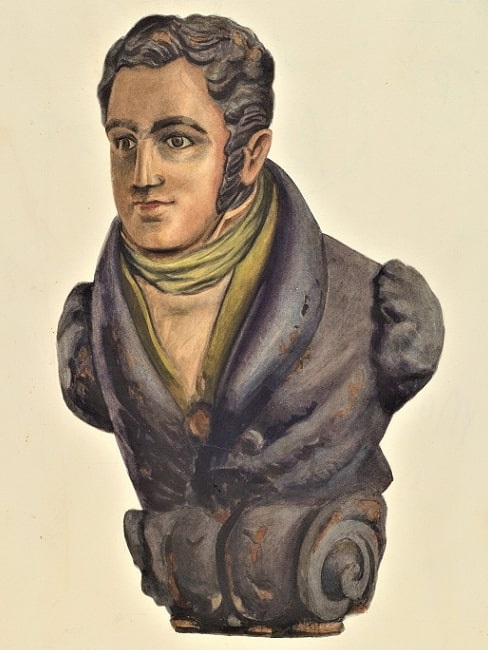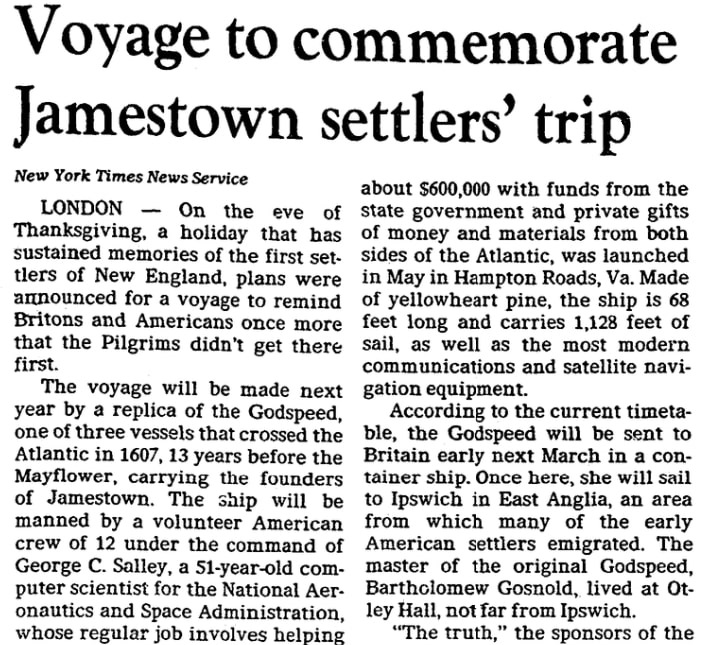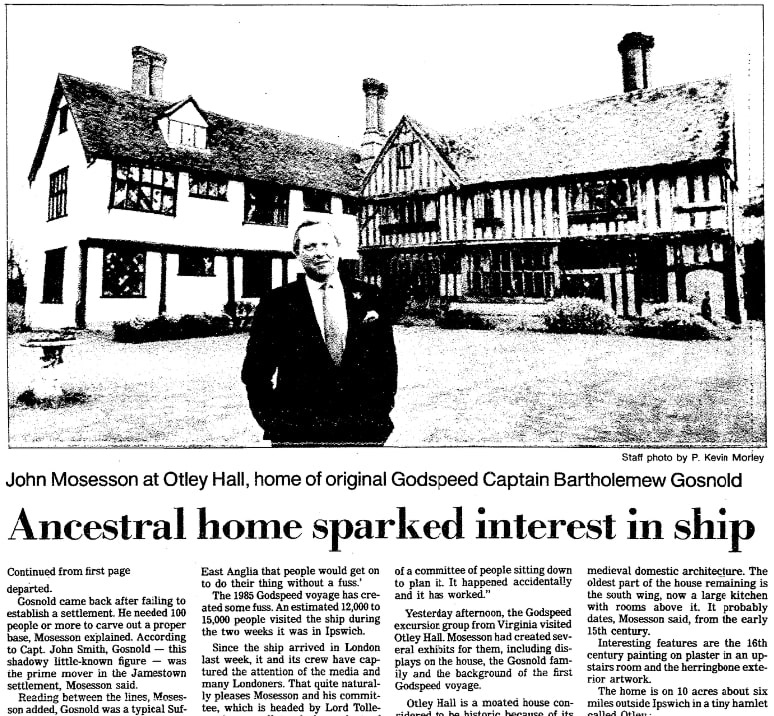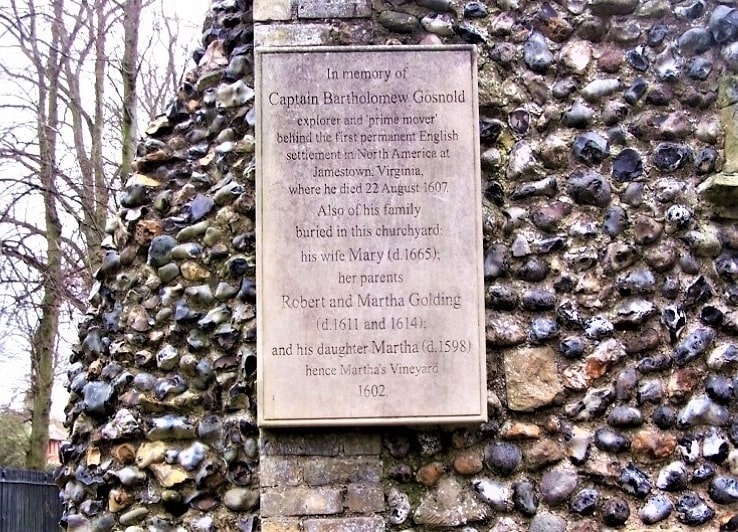Introduction: In this article, Melissa Davenport Berry writes about Bartholomew Gosnold, who was instrumental in founding the Jamestown Colony in Virginia in 1607. Melissa is a genealogist who has a website, americana-archives.com, and a Facebook group, New England Family Genealogy and History.
“Land. Life. Resurrection. The true adventure. Coming out of the vast unknown, out of the immensity, into safe harbor at last. That – that – is the New World.”
–Sir Walter Raleigh, clip from the movie “Elizabeth I: The Golden Age”
Today I continue with Captain Bartholomew Gosnold (1571-1607), the English maritime adventurer who played an instrumental role in the early exploration of America and the settlement of Virginia’s Jamestown Colony.
To recap: Gosnold discovered and named Cape Cod and Martha’s Vineyard in 1602. (See: Capt. Gosnold’s 1602 Adventure in the New World.)

During some of his travels, Gosnold sailed with friend Sir Walter Raleigh – and the sea rovers had the encouragement of Sir Richard Hakluyt, geographer to Queen Elizabeth I, who was an active promoter of colonization.
John Frederick Dorman, in “Adventurers of Purse and Person, Virginia, 1607-1624/5: Families G-P,” noted that the funding for Gosnold’s enterprise was largely due to his pedigree and political connections. He stated:
His success in enlisting support for a second venture to the new world backed by “ceratine of the nobilities, gentrie, and marchants” of England was due in part to his lineage and his connections with well-known families of Bacon, Naunton, Wingfield, Tallmache, and Windsor. Moreover, he married into the family of Sir Andrew Judd, wealthy merchant, whose grandson [was] Sir Thomas Smith/Smythe [married to Alice Judd, aunt to Bartholomew] of the East India Company and presiding Treasurer upon the organization of the Virginia Company.
Gosnold used his connections to obtain a charter from King James I for the Virginia Company to colonize Virginia. He captained the Godspeed, one of the three ships that sailed across the Atlantic in 1607 to found Jamestown.
Gosnold had the patronage of Matthew Scrivener, who became the Acting Governor of Jamestown, and was cousin to Edward Maria Wingfield, who became president of the new colony.
Matthew Scrivener and Gosnold’s brother, Anthony Gosnold, drowned in an accident in 1609 trying to cross to Hog Island in a storm along with six others.
Gosnold himself died just four months after the Jamestown settlers landed, on 22 August 1607. Sadly, his name is not even mentioned in “The 350th Anniversary of Jamestown, 1607-1957: Final Report to the President and Congress.”
However, he was highly recognized in the 1980s when his descendant Lord Timothy Tollemache, 5th Baron Tollemache, along with a large committee helped to finance a replica of the Godspeed to sail its original course from England to Virginia. It was also part of the celebration of the 350th anniversary of the founding of Hampton, Virginia.
Lord Tollemache served in the House of Lords and noted there was a large painting depicting the Mayflower voyage and the Plymouth settlement in Massachusetts hanging in the House of Parliament, but not one of the Virginia voyagers that sailed to Jamestown.
The Dallas Morning News noted that the plans for the endeavor were finalized, fittingly, on the eve of Thanksgiving, a holiday celebrating the first settlers of New England – to remind both Britons and Americans once more that the Pilgrims didn’t get here first.

This article reported:
The voyage will be made next year by a replica of the Godspeed, one of three vessels that crossed the Atlantic in 1607, 13 years before the Mayflower, carrying the founders of Jamestown. The ship will be manned by a volunteer American crew of 12 under the command of George C. Salley, a 51-year-old computer scientist for the National Aeronautics and Space Administration, whose regular job involves helping to plan the first permanent colony in space.
Virginians have always considered the Pilgrims as Johnny-come-latelies who get all the attention in the history books because of Miles Standish, Plymouth Rock, and Thanksgiving.
The Godspeed, built at a cost of about $600,000 with funds from the state government and private gifts of money and materials from both sides of the Atlantic, was launched in May in Hampton Roads, Va. Made of yellowheart pine, the ship is 68 feet long and carries 1,128 feet of sail, as well as the most modern communications and satellite navigation equipment…
“The truth,” the sponsors of the voyage said Wednesday, “is that the American nation did not start from a group of devout refugees fleeing religious and political persecution, but from a group of ordinary people from Norfolk and Suffolk, mostly farmers and tradesmen, who saw in the New World adventure and opportunities lacking at home.”
The article confirmed that Gosnold was the master of the original Godspeed and lived in England at Otley Hall, not far from Ipswich. He was not only the commander of the Godspeed, he was vice admiral of the expedition. The Jamestown settlers crossed the Atlantic in three ships. Along with the Godspeed, the fleet included the Susan Constant, under Captain Christopher Newport, and the Discovery, under Captain John Ratcliffe.
In 1985 when the Godspeed replica was docked at Ipswich, England, for two weeks before its departure, many Virginians toured Otley Hall where the owner, John Mosesson, opened an exhibit of the families’ relics.

Mosesson explained that his interest in Gosnold’s exploration was sparked when he visited Virginia in 1982 and was curious about Gosnold Hall at Christopher Newport College. When the project of the Godspeed replica was initiated Mosesson served on the committee. He noted that Captain John Smith had recorded “Gosnold was the prime mover in the Jamestown settlement.”
This article further reported:
“Bartholomew Gosnold was a relatively energetic chap,” Mosesson said, “and he read law at Cambridge University. Among his cousins were Gosnolds of high station in England, including the chief of protocol for Queen Elizabeth I and King James I.”
A commemorative plaque to Bartholomew Gosnold and his family is at the Chapel of the Charnel, the Great Churchyard of St Edmundsbury Cathedral, Suffolk, England.

The inscription on the plaque reads:
In memory of Captain Bartholomew Gosnold, explorer and prime mover behind the first permanent English settlement in North America at Jamestown, Virginia, where he died 22 August 1607. Also of his family buried in this churchyard: his wife Mary (d. 1665); her parents Robert and Martha Golding (d. 1611 and 1614); and his daughter Martha (d. 1598), hence Martha’s Vineyard, 1602.
To be continued…
Explore over 330 years of newspapers and historical records in GenealogyBank. Discover your family story! Start a 7-Day Free Trial.
Note on the header image: Capt. Bartholomew Gosnold was cast in bronze and placed beside the Williamsburg/James City County Courthouse. The unveiling took place on 8 July 2016 to honor his role in the settlement of Jamestown in 1607. Courtesy of Adrienne Berard Virginia.
Related Articles:
- Gosnold’s 1602 Adventure in the New World
- Bartholomew Gosnold: New World Adventurer
- Gosnold’s letter to father first voyage 1602
- Gosnold and Bacon. The ancestry of Bartholomew Gosnold. A collection

Excellent Melissa, love it!